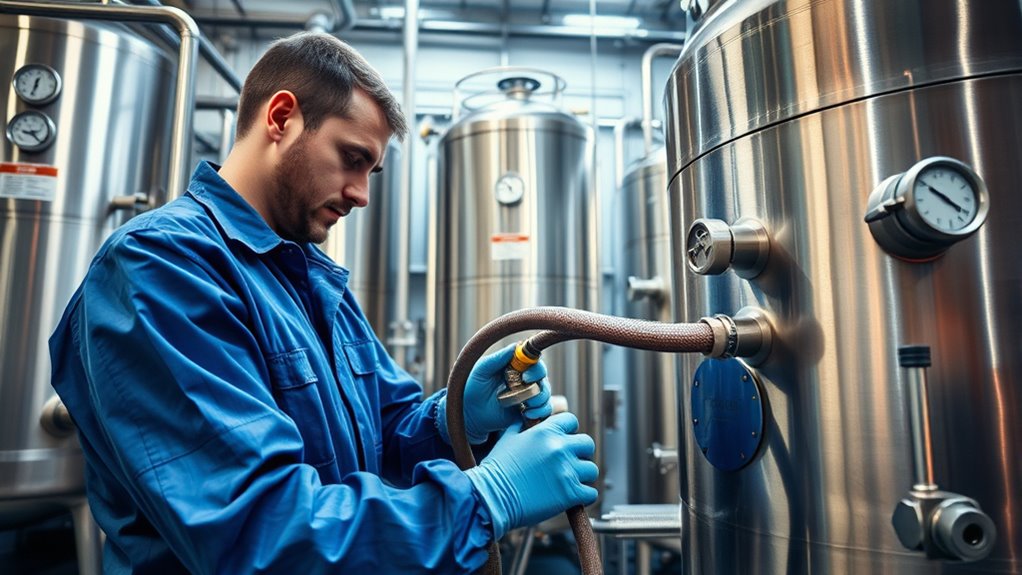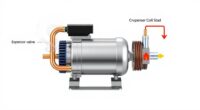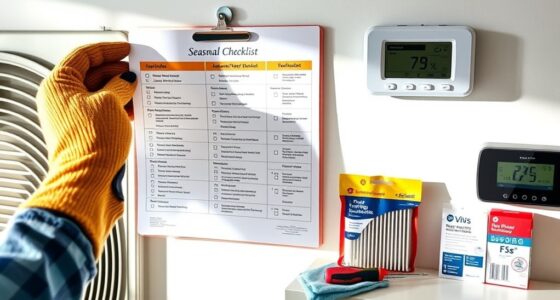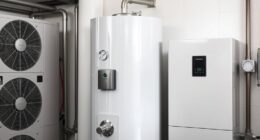When disposing of end-of-life equipment, you must follow regulations to safely recover and recycle refrigerants, preventing environmental harm. This involves proper decommissioning techniques like leak detection, depressurization, and secure handling. Using certified equipment and adhering to approved procedures help minimize risks. As regulations evolve, staying updated ensures compliance. If you want to learn more about best practices, innovative technologies, and how to address common challenges, continue exploring these essential processes.
Key Takeaways
- Follow local regulations and use certified equipment to ensure safe refrigerant recovery and proper disposal at end-of-life.
- Properly depressurize and leak-test equipment before disassembly to prevent environmental contamination.
- Recover refrigerants using approved methods, documenting transfer processes for compliance and tracking.
- Recycle refrigerants responsibly with certified facilities, maintaining high purity levels and adhering to environmental standards.
- Stay updated on evolving regulations and technological innovations to ensure safe, efficient, and sustainable disposal practices.
Understanding the Importance of Proper Disposal
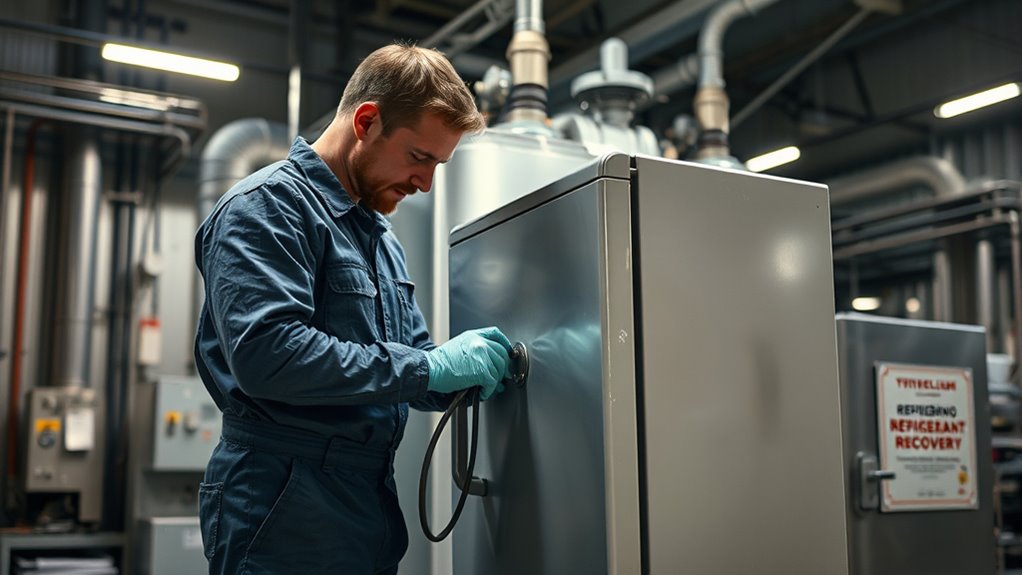
Proper disposal of end-of-life refrigeration units is essential because improper handling can lead to environmental contamination and health risks. When refrigerants leak, they harm the ozone layer and contribute to global warming, profoundly impacting the environment. Additionally, improper disposal can result in the release of hazardous materials, posing health hazards to workers and nearby communities. Considering cost considerations is also vital; although proper disposal may seem costly upfront, it prevents expensive cleanup efforts and potential legal penalties later. By prioritizing responsible disposal, you protect the environment and avoid financial liabilities. Proper handling ensures refrigerants are safely recovered and recycled, reducing pollution and safeguarding public health. Moreover, using specialized equipment for refrigerant recovery enhances safety and efficiency during disposal processes. Ultimately, understanding the importance of proper disposal helps you make environmentally responsible and cost-effective decisions.
Regulations Governing End-of-Life Equipment
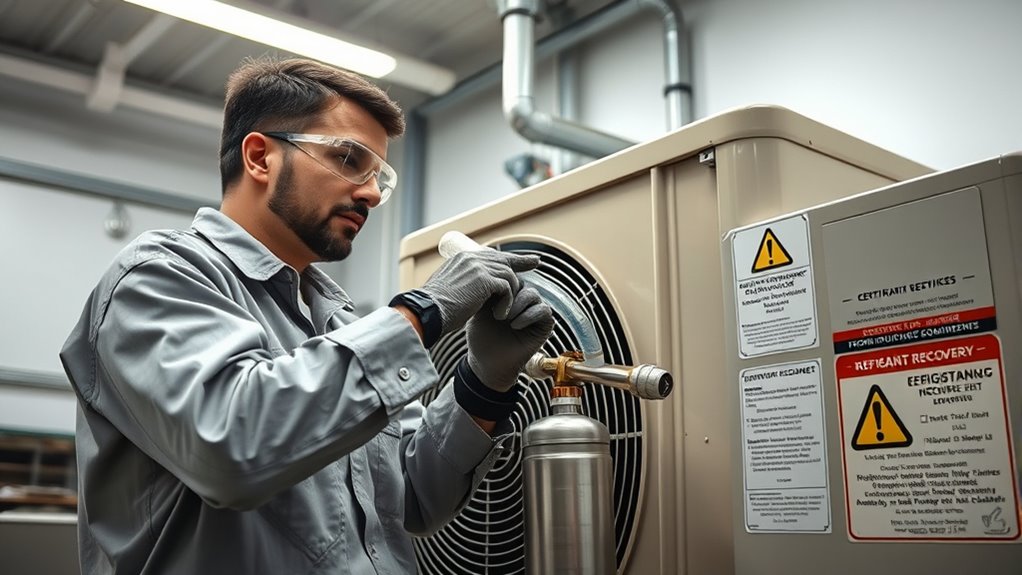
You need to understand the regulations that govern end-of-life equipment to stay compliant. These standards outline proper disposal procedures and guarantee environmental safety. Knowing these rules helps you avoid penalties and protect the environment effectively. Additionally, understanding personal growth concepts such as mindfulness and stress management can support healthier decision-making during disposal processes.
Regulatory Compliance Standards
Regulatory compliance standards establish the legal framework that governs the proper disposal and recovery of refrigerants from end-of-life equipment. These standards ensure you follow proper procedures, aligning with environmental protections and safety requirements. They often include recycling incentives to encourage responsible refrigerant recovery and proper handling. Understanding disposal logistics is vital to meet legal demands and prevent penalties. Compliance involves adhering to regulations from agencies like the EPA or local authorities, which specify refrigerant containment, recordkeeping, and reporting. Proper training on refrigerant handling is essential to ensure compliance and safety during recovery processes. Below is a quick overview:
| Regulation Aspect | Key Requirement |
|---|---|
| Recycling Incentives | Promote responsible refrigerant recovery |
| Disposal Logistics | Properly transport and store equipment |
| Recordkeeping | Document refrigerant recovery efforts |
| Reporting | Submit compliance reports regularly |
| Enforcement | Penalties for violations |
Proper Disposal Procedures
Ensuring compliance with disposal regulations is essential when managing end-of-life refrigeration equipment. Proper disposal procedures help prevent environmental harm and ensure safety. You should be aware of local regulations governing refrigerant recovery and disposal logistics to avoid penalties. Take advantage of recycling incentives offered by authorities or manufacturers to facilitate responsible disposal. When planning disposal, consider the following:
- Properly document refrigerant removal and transfer processes
- Coordinate with certified recycling facilities to streamline logistics
- Stay updated on evolving regulations to maintain compliance
Methods for Safe Equipment Decommissioning
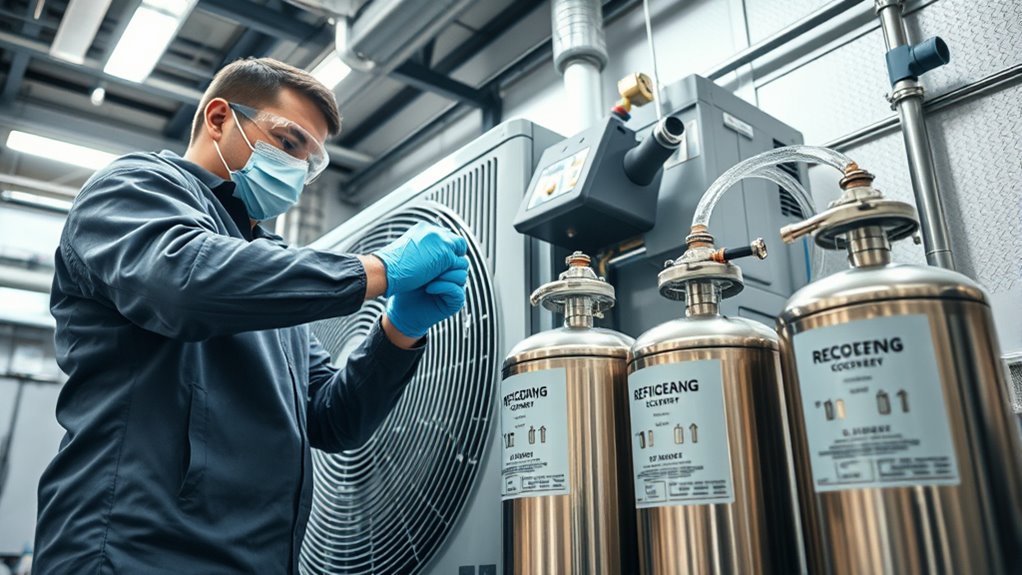
To safely decommission equipment, you need to follow proper depressurization procedures to release any remaining refrigerant. Make sure to drain the equipment correctly to prevent leaks or spills, and always use certified disposal practices to handle components responsibly. Following these steps helps protect the environment and guarantees compliance with regulations. Additionally, consulting industry-specific guidelines ensures that the decommissioning process aligns with Vetted – Mother Baby Kids safety standards.
Depressurization Procedures
Depressurization is a critical step in safely decommissioning refrigeration equipment, preventing the release of hazardous refrigerants into the environment. Proper procedures guarantee leak detection is thorough, reducing environmental impact. You should carefully plan the depressurization process, ensuring all safety protocols are followed. Key steps include isolating the equipment, gradually releasing pressure, and monitoring for leaks throughout. Additionally, understanding the refrigerant recovery process helps ensure all refrigerants are safely removed and contained. By implementing these practices, you minimize the risk of refrigerant escape, which can harm the environment and pose safety hazards. Effective leak detection during depressurization confirms that no residual refrigerant remains, safeguarding both personnel and the environment. Always verify that the system is depressurized before proceeding to further decommissioning steps, ensuring a responsible and compliant end-of-life process.
Proper Equipment Drainage
After completing depressurization, properly draining the equipment is essential to prevent residual refrigerants from escaping during disassembly. Ensure all valves are closed and refrigerant lines are thoroughly drained into approved recovery equipment. Proper equipment labeling is critical; clearly mark components containing residual refrigerant to avoid accidental release or misidentification during disposal. When selecting a disposal site, confirm it complies with local regulations and is equipped to handle drained equipment safely. Keep detailed records of drainage procedures and labeling to maintain compliance and facilitate proper disposal later. Thorough drainage minimizes environmental impact and enhances safety during decommissioning. Additionally, utilizing proper disposal procedures helps ensure compliance with environmental standards and reduces potential liabilities. By following these steps, you ensure a safer, compliant process that reduces the risk of refrigerant leaks and environmental contamination.
Certified Disposal Practices
Implementing certified disposal practices is essential to guarantee equipment is decommissioned safely and in compliance with regulations. Proper disposal certification ensures that hazardous waste, including refrigerants and other materials, is handled correctly. This minimizes environmental impact and reduces liability risks. To achieve this, you should:
- Verify that disposal methods meet industry standards and regulatory requirements
- Use certified facilities with proper handling procedures for hazardous waste
- Document all steps to maintain compliance and facilitate audits
- Incorporate emotional support strategies to manage stress and ensure thorough procedures during decommissioning
Adhering to certified disposal practices helps prevent leaks of refrigerants and hazardous substances, safeguarding public health and the environment. Ensuring proper disposal certification not only aligns with legal mandates but also demonstrates your commitment to responsible end-of-life equipment management.
Techniques for Effective Refrigerant Recovery
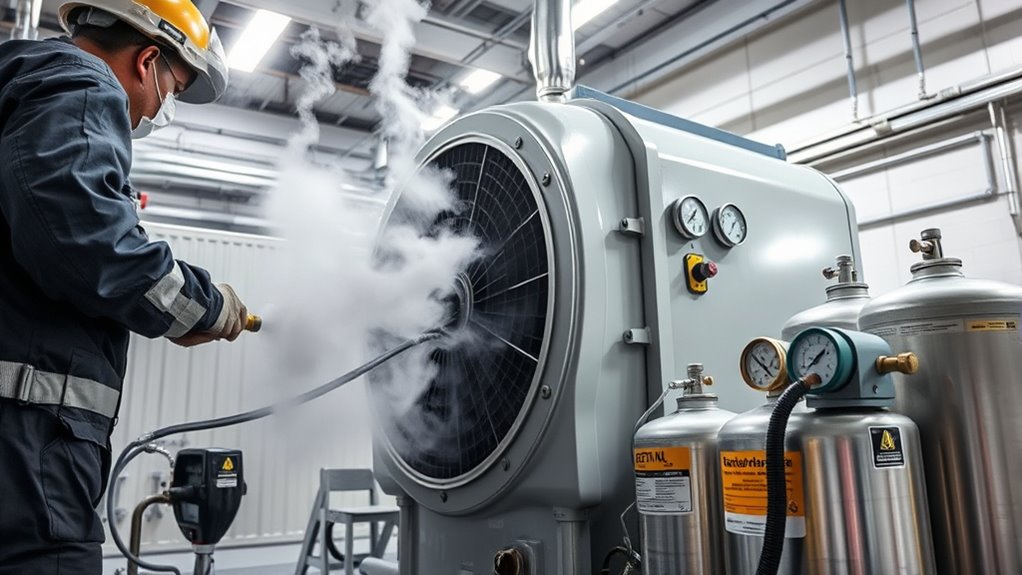
To recover refrigerants effectively, you need to use appropriate techniques that guarantee safety, efficiency, and environmental compliance. Begin by inspecting the equipment for refrigerant leakages and addressing any issues before recovery. Proper equipment labeling is vital to confirm you’re handling the correct refrigerant type and following manufacturer guidelines. Use approved recovery machines designed for the specific refrigerant, and connect hoses securely to prevent leaks during transfer. Always monitor pressure gauges closely to avoid over-pressurization or accidental releases. Make sure to vent refrigerant slowly and steadily, avoiding rapid depressurization that could harm the environment or equipment. Following these techniques helps maximize recovery efficiency while minimizing environmental impact and ensuring safety throughout the process.
Handling and Recycling Refrigerants Responsibly

Proper handling and recycling of refrigerants play a vital role in protecting the environment and guaranteeing safety. You should follow strict protocols for refrigerant recovery, emphasizing disposal ethics to prevent leaks and contamination. Recycling innovations have advanced considerably, allowing for more efficient and eco-friendly reprocessing of refrigerants. This means you can restore refrigerants to high purity levels, reducing waste and conserving resources. Always use certified equipment and trained personnel to minimize environmental impact. By prioritizing responsible practices, you help limit ozone depletion and greenhouse gas emissions. Staying informed and committed to these principles ensures you contribute positively to environmental protection and industry standards. Additionally, understanding refrigerant purity levels is essential for ensuring the effectiveness of recycled refrigerants and compliance with regulations.
Common Challenges and How to Overcome Them
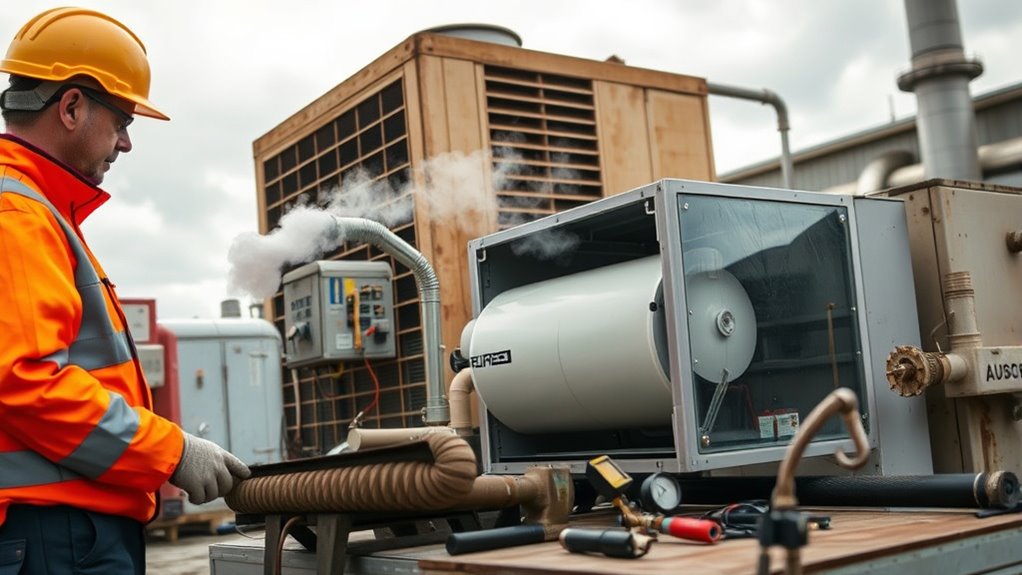
Handling refrigerant disposal and recovery often presents challenges such as equipment failures, leaks, and contamination risks. These issues can turn refrigerants into hazardous waste if not managed properly, increasing environmental impact. Equipment failures may cause refrigerant leaks, releasing harmful substances into the atmosphere. Contamination from dirt or moisture complicates recovery efforts and can lead to unsafe disposal practices. To overcome these challenges, guarantee regular maintenance of recovery and disposal equipment, and train staff thoroughly. Using certified, well-maintained tools reduces leaks and contamination risks. Proper labeling and storage prevent accidental releases, minimizing hazardous waste generation. Additionally, understanding bank SWIFT/BIC codes can ensure secure financial transactions related to disposal services. By staying vigilant and following best practices, you protect the environment, minimize hazardous waste, and ensure smooth refrigerant recovery and disposal processes.
Future Trends in Disposal and Recovery Technologies
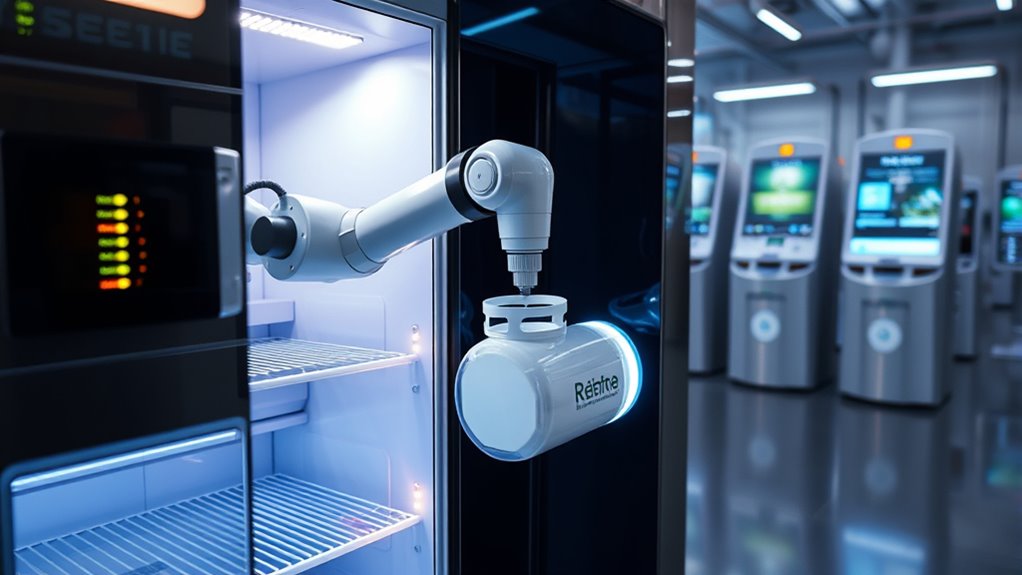
Advancements in disposal and recovery technologies are shaping a more sustainable future for refrigerant management. Future innovations focus on enhancing efficiency, reducing environmental impact, and promoting innovative recycling methods. You can expect the development of smarter, more automated recovery systems that minimize refrigerant loss and improve safety. Additionally, emerging technologies aim to recover refrigerants from complex or contaminated sources, broadening disposal options. These innovations will likely incorporate advanced sensors and AI-driven controls for real-time monitoring and optimization. AI security is increasingly relevant as these systems become more integrated and reliant on intelligent technologies.
Frequently Asked Questions
What Are the Environmental Impacts of Improper Refrigerant Disposal?
When refrigerants leak into the environment, they can cause significant harm, including ozone depletion and global warming. Improper disposal allows these chemicals to escape, contributing to air pollution and damaging the ozone layer. You might not realize it, but failing to properly manage refrigerants increases the risk of leaks, which accelerates environmental damage. Proper disposal and recovery are essential to prevent these impacts and protect our planet’s atmosphere.
How Do Costs Vary Between Different Disposal and Recovery Methods?
Oh, the joy of comparing costs—who knew disposal could be so exciting? You’ll find that service pricing varies widely depending on the method chosen. For example, recycling may be cheaper than disposal, but some methods include extra fees. The cost comparison ultimately hinges on the specific technique and provider. So, don’t forget to shop around and weigh the environmental benefits against your budget—your wallet will thank you!
Are There Any Certification Requirements for Technicians Handling Refrigerants?
When handling refrigerants, you need to meet certification standards that guarantee safe and proper practices. Technician training programs are designed to help you understand these standards and gain the necessary certifications. These certifications prove your competence, making sure you’re qualified to handle refrigerants responsibly. Without proper certification, you can’t legally perform recovery or disposal tasks, emphasizing the importance of ongoing training to stay compliant and safe in your work.
What Are the Potential Legal Penalties for Non-Compliance?
Imagine you skip proper refrigerant recovery and face a leak. You could encounter serious legal consequences, including hefty fines or license suspension. Penalty enforcement is strict, and authorities target violations to safeguard the environment. Non-compliance risks not only legal penalties but also damage to your professional reputation. Staying compliant ensures you avoid costly fines and supports responsible environmental practices, emphasizing the importance of following regulations diligently.
How Can Technology Improve Efficiency in Refrigerant Recovery Processes?
You can improve efficiency in refrigerant recovery by utilizing automated recovery systems, which streamline the process and reduce manual effort. Digital monitoring tools help you track recovery progress in real-time, ensuring compliance and preventing leaks. These technologies minimize errors, save time, and enhance safety, making your refrigerant recovery more effective. Embracing automation and digital monitoring allows you to optimize operations and stay ahead of regulatory requirements.
Conclusion
Think of end-of-life disposal and refrigerant recovery like tending a garden—you must prune carefully to protect what’s healthy and ensure new growth. When you follow proper procedures, you prevent leaks and environmental harm, much like removing dead branches prevents disease. By staying current with regulations and using best practices, you’re not just disposing of equipment; you’re nurturing a safer, greener future. Your responsible actions today plant the seeds for a healthier planet tomorrow.
